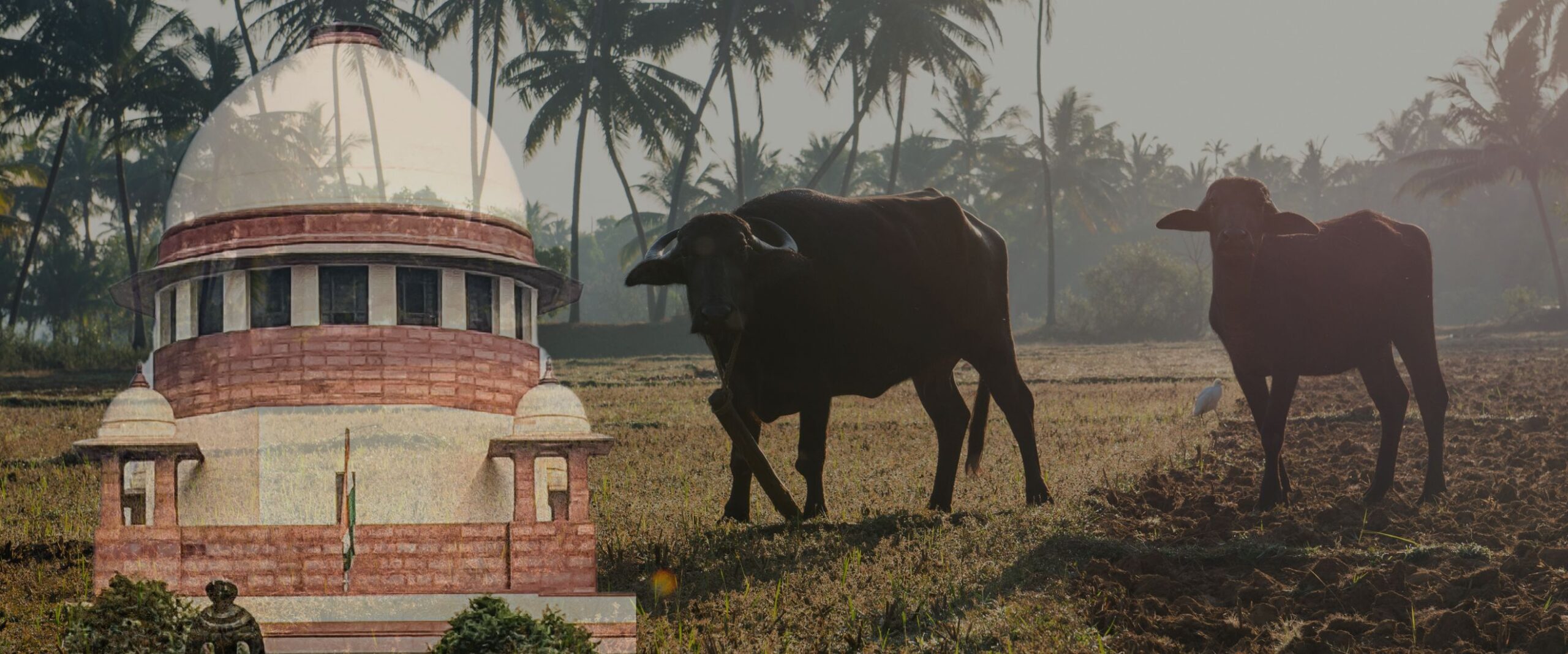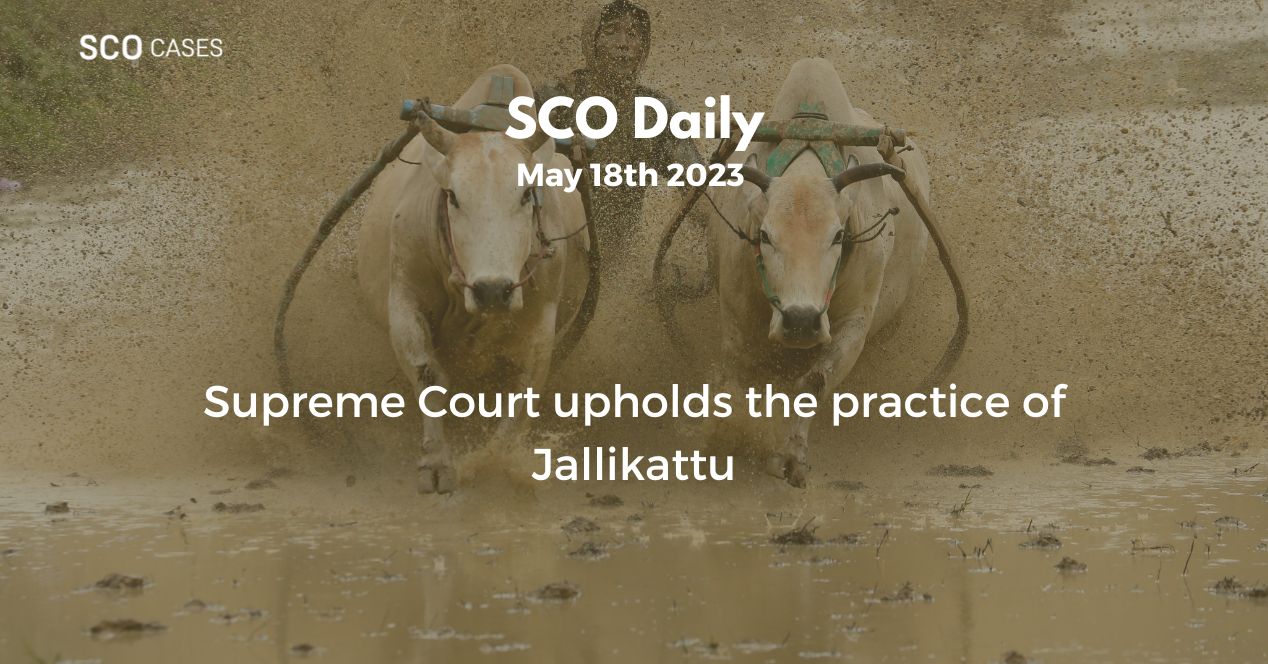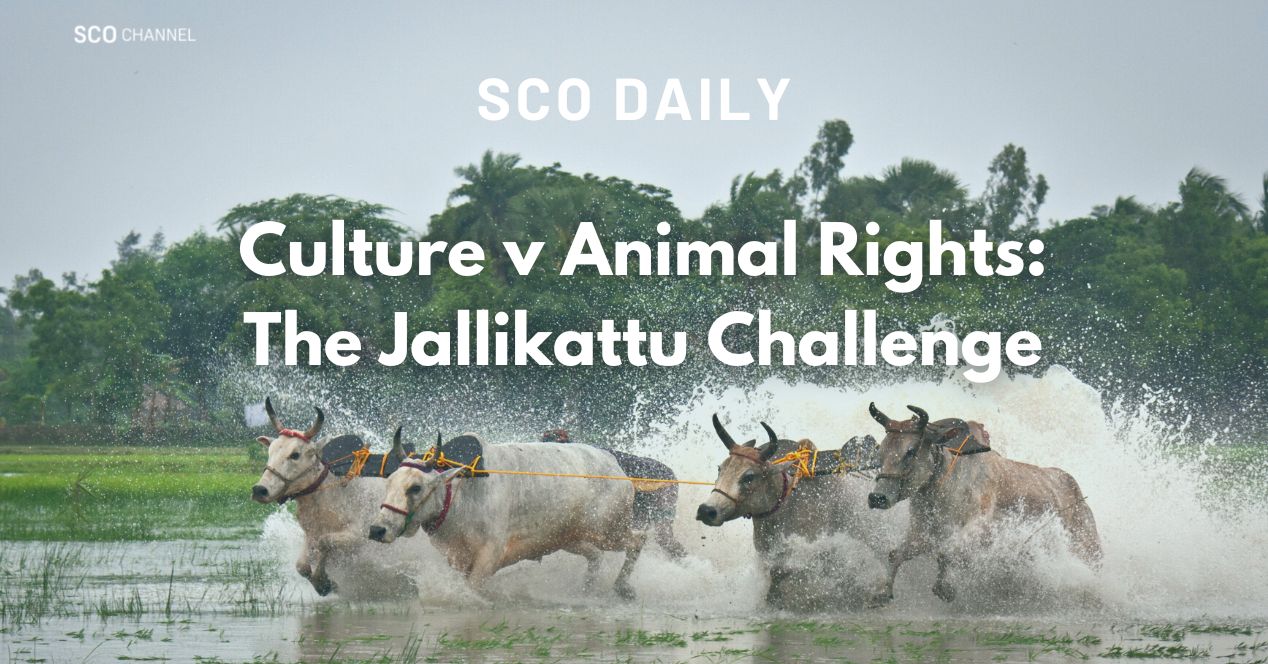Analysis
Interview: Mr. Alok Hisarwala Gupta on Jallikattu and Animal Rights
Animal rights activist Mr. Alok Hisarwala Gupta discusses the SC verdict which upheld Jallikattu, and its impact on the rights of animals.

The Supreme Court upheld the practice of Jallikattu or bull taming in Tamil Nadu in a Constitution Bench Judgment on May 18th, 2023. SCO interviewed Mr. Alok Hisarwala Gupta, lawyer and animal rights activist, about the impact of the Judgement, and what this means for animal rights in India.
In Conversation:
The Judgement stated that the TN Amendment and Rules “seek to substantially minimise the pain and suffering and continue with the traditional sports”. Do the rules and framework for organising the sport of bull-taming effectively combat the issues of cruelty? What measures have been taken in the Amendment Act and the Rules, that may have led to the Court to believe that the defects pointed out in A. Nagaraja has been cured?
Alok Gupta: Like many working on Animal Rights, words cannot describe the deep sense of loss and disappointment at the Constitutional Bench’s decision in Animal Welfare Board of India (May 2023). The Hon’ble Supreme Court’s reversal of its own 2014 Jallikattu Ban, protecting and elevating the cultural defence to exploit animals for entertainment – in the year 2023, contrary to a rising global trend calling for better protection of the interest of animals, is indeed a great setback to animal rights as well as environment justice.
The 2014 Nagaraja Judgment was not without its imperfections but is widely recognized as a watershed moment within the limited space of animal-centric jurisprudence. Nagaraja took the leap to protect non-human animals within the fold of Article 21, by relying on three things: our legislative duty under the Prevention of Cruelty to Animals Act, 1960 (PCA Act); international common law understanding of the five animal welfare principles; and finally drawing meaning and value from our 42nd Constitutional Amendment in 1974 which added “compassion to living beings” as a fundamental duty of every Indian citizen.
But politically, Nagaraja did something even more radical, which has also made its reception so controversial in India. It created a possibility, a road map, through the test of an “inherently cruel practice” for getting animals out of the closed trap of animal welfare. Allow me to explain this with a brief historical context.
The PCA Act, founded on a 19th century common law principle, limited the protection offered to animals against “cruelty” from unnecessary to necessary suffering. So, to protect animals from cruelty all we could really do is argue for some reduction in the suffering being caused, never its complete and absolute cessation. The protection of the human interest to use and exploit animals has always been a higher value that cannot be negotiated, only the manner in which the animal is “handled” can be made less severe.
This changed in the year 1998, when the government of India introduced a notification to ban five wild animals – bears, tigers, lions, panthers, and monkeys, from circuses. This was a radical moment and signalled a strong, secular, animal-centric policy to go beyond the limitations of the PCA Act. Therefore, we did not merely reduce the suffering of the five wild animals in circuses, but effectively liberated them from the process of exploitation.
This notification was challenged by the circus owner association, and the ban was upheld by the Kerala High Court and the Hon’ble Supreme Court in the 2000 N R Nair decisions. It was a noble policy framework, the right step, as there was and continues to be, wider popular support to not exploit and torture animals for entertainment.
The concluding para in the Kerala High Court’s decision creates, arguably, the first ever animal-centric judicial foundation in our modern jurisprudence:
In conclusion, we hold that circus animals are being forced to perform unnatural tricks, are housed in cramped cages. subjected to fear, hunger, pain, not to mention the undignified way of life they have to live with no respite and the impugned notification has been issued in conformity with the changing scenario, values of human life, philosophy of the Constitution, prevailing conditions and the surrounding circumstances to prevent the infliction of unnecessary pain or suffering on animals. Though not homosapiens. they are also beings entitled to dignified existences and humane treatment sans cruelty and torture. In many respects, they comport better than humans, they kill to eat and eat to live and not live to eat as some of us do, they do not practise deception, fraud, or falsehood and malpractices as humans do, they care for their little ones expecting nothing In return, they do not proliferate as we do depleting the already scarce resources of the earth, for they practise sex restraint by seasonal mating, nor do they inhale the lethal smoke of tobacco polluting the atmosphere and inflicting harm on fellow beings. All animals except the very lowest exhibit some degree of intelligent behaviour, ranging from learned responses to complex reasoning. Many believe that the lives of humans and animals are equally valuable and that their interests should count equally. Their contribution to the health of human is invaluable, once it is remembered that nearly every advance in health care and combating human diseases been based on animal research. Animals also provide models for the study of human diseases. New drugs are tested on animals to help determine their potential for causing cancer or other disease or for harming embryos and foetuses in the womb. Therefore, it is not only our fundamental duty to show compassion to our animal friends, but also to recognise and protect their rights. If humans are entitled to fundamental rights, why not animals’? In our considered opinion; legal rights shall not be the exclusive preserve of the humans which has to be extended beyond people thereby dismantling the thick legal wall with humans all on one side and all non-human animals on the other side. While the law currently protects wildlife and endangered species from extinction, animals are denied rights, an anachronism which must necessarily change.
I would argue that the movement to ban Jallikattu – as a cruel animal sport, that serves no meaningful human purpose – began both through documentation of cruelty, torture and human and animal fatalities because of the sport; but also from the philip provided by N R Nair which created the possibility of protecting animals from harm both as our collective fundamental right and duty.
In 2011, after six years of litigation and court orders, including a 2010 Supreme Court order, the Ministry of Environment and Forest, which was then concerned with animal welfare, convinced that Jallikattu is inherently cruel and cannot be made less cruel, included male bovines in the 1998 notification and banned them from use for any entertainment in any sport. This is the genesis behind the 2014 Nagaraja decision. And also the real life story of Nagaraja himself, a village farmer, who lost is young teenage son during a Jallikattu event in 2006.
Thus, building on NR Nair, Justice Radhakrishnan in Nagaraja, in one of the most animal-centric discussion looking at the sport from the perspective of the bovine animal concerned, based on multiple expert reports and statements concludes that the sport is inherently cruel. The court argued that it is not the natural behaviour of a bovine animal to run or race in the manner in which these sports required. The animals ran in a fight or flight response as a result of the torture they were subjected to. The court found no possibility of making the sport less cruel, as torture is a key ingredient to get the bovine animal to perform.
The 2017 TN Amendment has failed to alter the violence, torture, cruelty and the consequent dangers to both human and animal life, linked to Jallikattu. In fact, it is particularly sad that the Constitution Bench’s entire decision rests upon the manner in which the sport has been altered, to side step the finding in Nagaraja, without actually discussing the nuts and bolts of what that change means.
Unfortunately, soon after the Constitutional bench reserved judgement in December 2022 (five months before the judgement), after weeks of passionate arguments from all sides, Jallikattu season began in Tamil Nadu. It was one of the most violent and cruel Jallikattu seasons ever recorded in history, despite claims made before the Court of new guidelines. A detail documentation done by Elsa Foundation has confirmed that over 100 people and more than 20 bulls have died from Jallikattu since 2017 in Tamil Nadu.
This overwhelming statistic which was present before the Court remained unappreciated and unacknowledged, particularly because it conclusively refutes the claim that the sport as played today is different and less cruel.
All the gains stand undone, and we are back to working within the limited confines of “welfare” to play a sport that necessitates “torture”, under the political force of culture, which now has an additional stamp of judicial support. The days and years ahead will be a great challenge for animal activists and of course the bovine animals themselves.
The Constitution Bench accepted the TN Legislature’s view that Jallikattu forms a cultural right. How is Article 29(1) read to include practices like Jallikattu within its ambit? How is the ambit of cultural rights under Art. 29 determined? Can practices of ‘any section of citizens’ or communities be rooted in 29?
Alok Gupta: Instead of focussing on what the bench has said – that we don’t have enough evidence, or expertise to determine culture, let’s read between the lines. The judgement is making a clear hierarchy, don’t ask us to review animal suffering with the same level of scrutiny with which we view human suffering.
Without going into whether there is a cultural claim or not, my argument is slightly different. Once, as was done in Nagaraja, expert, objective facts determine that a certain practice is premised on torture, as a key, non-negotiable ingredient, and all it primarily serves is “entertainment”, this finding in itself must be the driving force to re-examine culture.
Nagaraja is a decision about bodily integrity and autonomy of non-human animals, who share a deep conviction with us, to live natural, free lives. Any deviation to that natural right of the animal must come with many conditions. Torture, culture and entertainment should not be allowed to waive autonomy.
Here unfortunately we have two camps, one that believes in a narrow reading of the Constitution with no scope for inclusion of animals, and the other – that I belong to – where our Constitution was always meant to cure, address and respond to suffering of humans, nature and non-human animals.
The making of the animal interest as a relevant consideration in a Constitutional deliberation is a progression of our Article 21 jurisprudence on socio-economic rights and environmental justice. It is important here to note that Justice Radhakrishnan, aside from Nagaraja, gave us the principle of eco-centricity as a counter to an anthropocentric view in environment jurisprudence in TN Godavarman 2012 and declared long before Navtej, and despite Suressh Koushal, that transgender people had dignity in the widely celebrated NALSA (2014) Judgement.
He saw the non-human animals as the outliers as they are. NR Nair and Nagaraja have gone on to inspire a plethora of decisions from across High Courts protecting animal interests, in an incremental, and careful constitutional balance, sometimes to help stray dogs, or an elephant or a horse in need. The powerful transformative and positive impact of Nagaraja in our jurisprudence, has been erroneously undermined. We need to work towards restoring this.
PETA stated that it will explore other remedies to protect bulls after the Judgement. What do the next steps look like for animal welfare activists?
Alok Gupta: Constitutional Judgements must provide us with a certain finality consistent with the values our Constitution mandates. I personally think, with great respect, that the current Constitution Bench decision fails to provide such a finality.
The decision is a response to political outcry against something that society at large is not willing to accept. It is a submission, in a way, to popular morality, undermining the growing commitment in our jurisprudence to Constitutional morality.
Maybe it is a tall claim to include animals within the fold of Article 21. But we should be able to push the envelope – in incremental ways – to give meaning to our fundamental duties to show compassion to all living beings in Article 51 (A) (g)
Very recently we have seen something, slightly similar. In Suresh Koushal 2013, the Hon’ble Supreme Court struck down the Delhi High Court’s decision in Naz Foundation (2009) which decriminalised homosexuality. However, the Supreme Court in Navtej (2018), five year later, overruled Suresh Koushal and upheld Naz. I can sincerely hope that some room will be available to reargue, what I think are some core issues that remain unaddressed by the Constitution Bench’s decision in review.
Having said that, I also want to say to the community of animal rights activists, that: We need to revive this secular movement of animal rights (rooted in our Constitution), which works on transforming society where marginalised communities are our allies and partners. We need to work on the ground, engage with cultural arguments at its core, and work towards strategies that are rooted in communities and not constant calls for criminalisation of people who use/exploit animals. Hard as my advice right now sounds, our old tricks have failed.
Mr. Alok Hisarwala Gupta is a lawyer, activist and researcher working on LGBTQIA+ and animal rights. He is the founder of Centre for Research on Animal Rights.


